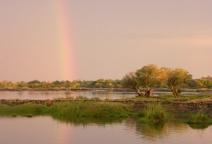Victoria Falls town began in 1901 when the possibility of using the waterfall for hydro-electric power was explored, and expanded when the railway from Bulawayo reached the town shortly before the Victoria Falls Bridge was opened in April 1905, connecting Zimbabwe to what is now Zambia. It became the principal tourism centre for the Falls. Victoria Falls is regarded as one of the greatest waterfalls in the whole world. Certainly many people think it is one of the most beautiful sights in the world! Upstream, the river flows through a wide valley. The Victoria Falls is 1 708 meters wide, making it the largest curtain of water in the world. Although Victoria Falls constitute neither the highest nor the widest waterfall in the world, the claim it is the largest is based on a width of 1.7 kilometres (1 mile) and height of 108 metres (360 ft), forming the largest sheet of falling water in the world. The falls' maximum flow rate compares well with that of other major waterfalls. It drops between 90m and 107m into the Zambezi Gorge and an average of 550,000 cubic metres of water plummet over the edge every minute! Long before you even see the waterfalls you can hear the roaring of the water! The native people call it "mosi-oa-tunya" which means "smoke that thunders." The falls were formed by a deep rift in the rock that lies directly across the path of the Zambezi River. The rift was caused by movement of the earth about 150 million years ago. The unusual form of Victoria Falls enables virtually the whole width of the falls to be viewed face-on, at the same level as the top, from as close as 60 metres, because the whole Zambezi River drops into a deep, narrow slot like chasm, connected to a long series of gorges. Few other waterfalls allow such a close approach on foot.
















